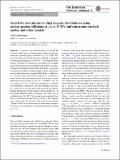Search for new physics in dijet angular distributions using proton–proton collisions at √s = 13 TeV and constraints on dark matter and other models
Author(s)
Abercrombie, Daniel Robert; Allen, Brandon Leigh; Azzolini, Virginia; Barbieri, Richard Alexander; Baty, Austin Alan; Bauer, Gerry P; Bi, Ran; Brandt, Stephanie Akemi; Busza, Wit; Cali, Ivan Amos; D'Alfonso, Mariarosaria; Demiragli, Zeynep; Gomez-Ceballos, Guillelmo; Goncharov, Maxim; Harris, Philip Coleman; Hsu, Dylan George; Hu, Miao; Iiyama, Yutaro; Innocenti, Gian Michele; Klute, Markus; Kovalskyi, Dmytro; Lee, Yen-Jie; Levin, Andrew Michael; Luckey Jr, P David; Maier, Benedikt; Marini, Andrea Carlo; McGinn, Christopher Francis; Mironov, Camelia Maria; Narayanan, Siddharth Madhavan; Niu, Xinmei; Paus, Christoph M. E.; Roland, Christof E; Roland, Gunther M; Stephans, George S. F.; Sumorok, Konstanty C; Tatar, Kaya; Velicanu, Dragos Alexandru; Wang, J.; Wang, Ta-Wei; Wyslouch, Boleslaw; Zhaozhong, S.; ... Show more Show less
DownloadSirunyan2018_Article_SearchForNewPhysicsInDijetAngu.pdf (1.060Mb)
PUBLISHER_CC
Publisher with Creative Commons License
Creative Commons Attribution
Terms of use
Metadata
Show full item recordAbstract
A search is presented for physics beyond the standard model, based on measurements of dijet angular distributions in proton–proton collisions at √s = 13 TeV. The data collected with the CMS detector at the LHC correspond to an integrated luminosity of 35.9 fb[superscript -1]. The observed distributions, corrected to particle level, are found to be in agreement with predictions from perturbative quantum chromodynamics that include electroweak corrections. Constraints are placed on models containing quark contact interactions, extra spatial dimensions, quantum black holes, or dark matter, using the detector-level distributions. In a benchmark model where only left-handed quarks participate, contact interactions are excluded at the 95% confidence level up to a scale of 12.8 or 17.5TeV, for destructive or constructive interference, respectively. The most stringent lower limits to date are set on the ultraviolet cutoff in the Arkani–Hamed–Dimopoulos–Dvali model of extra dimensions. In the Giudice–Rattazzi–Wells convention, the cutoff scale is excluded up to 10.1TeV. The production of quantum black holes is excluded for masses below 5.9 and 8.2TeV, depending on the model. For the first time, lower limits between 2.0 and 4.6TeVare set on the mass of a dark matter mediator for (axial-)vector mediators, for the universal quark coupling g[subscript q]= 1.0.
Date issued
2018-09Department
Massachusetts Institute of Technology. Department of Physics; Massachusetts Institute of Technology. Laboratory for Nuclear ScienceJournal
The European Physical Journal C
Publisher
Springer-Verlag
Citation
CMS Collaboration, et al. “Search for New Physics in Dijet Angular Distributions Using Proton–Proton Collisions at √s = 13 TeV and Constraints on Dark Matter and Other Models.” The European Physical Journal C, vol. 78, no. 9, Sept. 2018. © 2018, CERN for the benefit of the CMS collaboration.
Version: Final published version
ISSN
1434-6044
1434-6052